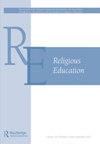Construction of Place: Creating a Religious Built Environment to Optimally Support a Child’s Entrance into Flow
IF 0.4
3区 哲学
0 RELIGION
引用次数: 0
Abstract
AbstractThere is significant research on the built environment’s support for children’s optimal learning in educational settings. While faith itself is transmitted through conversation with God, the process of conversation, as well as a child’s interaction and growth within their community, is affected by the physically built environment of the classroom. By filtering data through a lens of God’s gift of place, we can see what is often taken for granted or measured by adult standards. When place is viewed as the third teacher, best practices can help children enter a flow state of learning which supports their spiritual development.Keywords: built environmentchildren’s facilitiescreating communityChristian educationclassroomschildren’s optimal learning Disclosure statementNo potential conflict of interest was reported by the author(s).Additional informationNotes on contributorsElizabeth ViceElizabeth Vice has years of training and education both in human development, Montessori pedagogy, and theology. At Parkside, she combines all of these skills to assist the children as they live into the reality that they are loved by God. Email: eavice@mindspring.com场所的建构:创造一个宗教建筑环境,以最佳方式支持儿童进入心流
摘要在教育环境中,建筑环境对儿童最佳学习的支持已经得到了大量的研究。虽然信仰本身是通过与上帝的对话来传递的,但对话的过程,以及孩子在社区中的互动和成长,都受到教室物理环境的影响。透过上帝赐予的位置来过滤数据,我们可以看到什么是理所当然的,什么是用成年人的标准来衡量的。当地方被视为第三位老师时,最佳实践可以帮助孩子进入一种支持他们精神发展的学习流动状态。关键词:人造环境儿童设施创建社区基督教教育课堂儿童最佳学习披露声明作者未报告潜在的利益冲突。附加信息撰稿人说明伊丽莎白副伊丽莎白副有多年的培训和教育在人类发展,蒙台梭利教学法,和神学。在Parkside,她结合了所有这些技能来帮助孩子们,因为他们生活在上帝爱他们的现实中。电子邮件:eavice@mindspring.com
本文章由计算机程序翻译,如有差异,请以英文原文为准。
求助全文
约1分钟内获得全文
求助全文
来源期刊

RELIGIOUS EDUCATION
RELIGION-
CiteScore
0.90
自引率
28.60%
发文量
46
期刊介绍:
Religious Education, the journal of the Religious Education Association: An Association of Professors, Practitioners, and Researchers in Religious Education, offers an interfaith forum for exploring religious identity, formation, and education in faith communities, academic disciplines and institutions, and public life and the global community.
 求助内容:
求助内容: 应助结果提醒方式:
应助结果提醒方式:


